
Although brought up in Vienna and an irregular resident here, it would only be fair to describe the artist Friedensreich Hundertwasser as a citizen of the world. Nevertheless, he left a significant mark on the city’s physical and cultural landscape.
- See also:
Use the info below to find the main locations of interest if you wish to follow in the great man’s footsteps (with a location map at the end).
Hundertwasser: his work
Let’s begin with places to see the results of his creativity…
Kunst Haus Wien
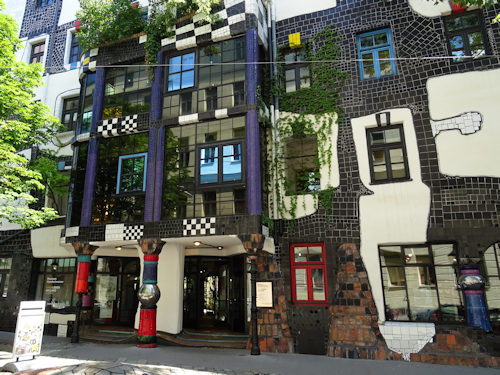
(The top Vienna address for Hundertwasser fans)
You might expect me to lead with the Hundertwasserhaus (see below) but the Kunst Haus Wien is a better option for those interested in Hundertwasser’s work.
Why?
Well, Hundertwasser designed (and founded) the institution, which houses the Hundertwasser Museum.
You have a double whammy of delights:
- First, the characteristic architecture, both inside and out, with its tree tenants, curved walls and floors
- Second, the exhibition, which chronicles Hundertwasser’s artistic evolution with the help of numerous works of art and similar
The in-house café offers something a little different to the more traditional Viennese establishments. Go to the toilet while there (trust me on this).
The Kunst Haus Wien also hosts, for example, regular special exhibitions of contemporary art along a green theme, fitting the Hundertwasser ethos.
Landing stage
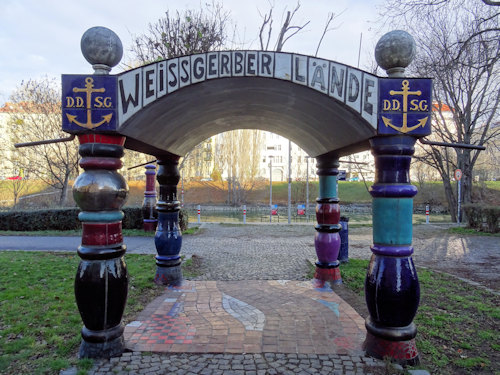
(The same area is also notable for the Jugendstil buildings that line the road running parallel to the river)
A quick skip and jump takes you from the Kunst Haus Wien to the Donaukanal (Danube Canal), an arm of the Danube that runs through the city centre.
Nature and hydrological engineers designed the Donaukanal, but landing stages dot the banks and Hundertwasser created the look of the one at Weißgerberlände 28 (just a short distance from the museum).
The paved walk along the river here is the Hundertwasser Promenade.
Hundertwasserhaus
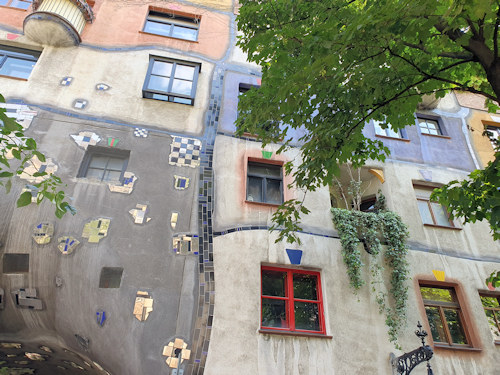
(Expect to find others admiring the building with you)
The distinctive 1985 Hundertwasserhaus apartment block has become one of Vienna’s prime tourist attractions.
This is “just” another council house run by the municipal authorities…but only if you ignore the astonishing shapes, colours, and integrated vegetation.
A lot of tours stop off here, so expect crowds. You can’t actually go inside, but Hundertwasser also helped design the small mall (the Hundertwasser Village) opposite the house.
Spittelau Incinerator
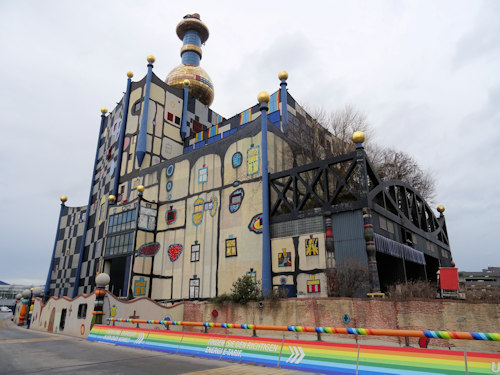
(The golden ball near the top of the chimney has become a distinctive city landmark)
Hundertwasser redesigned the chimney and entire façade of the Spittelau municipal incinerator in the late 1980s. The facility continues to provide energy, heat and warm water to thousands of households in Vienna.
Some might argue the architectural impact exceeds even that of the more well-known Hundertwasserhaus.
Tree tenants

(The building on the ground floor is a public library)
A first tree went into the façade of the building at Alterbachstraße 11 in 1981 as part of Hundertwasser’s tree tenant initiative.
A plaque outside in German and English commemorates the event. The hornbeam tree you see now (at least when I last looked) replaced the original, which suffered damage during renovation work.
Upper Belvedere

(Upper Belvedere: not a Hundertwasser design; he was born a couple of hundred years too late for that job)
The recent redesign of the permanent art exhibition at Upper Belvedere (famous for its Klimt collection) saw Hundertwasser’s 224 The Large Path painting reappear in the Avant Garde section.
Hundertwasser: life & more
Vienna rarely celebrates Hundertwasser in the same way it worships Klimt or Beethoven. But one or two landmarks exist related to his life and achievements.
Childhood home
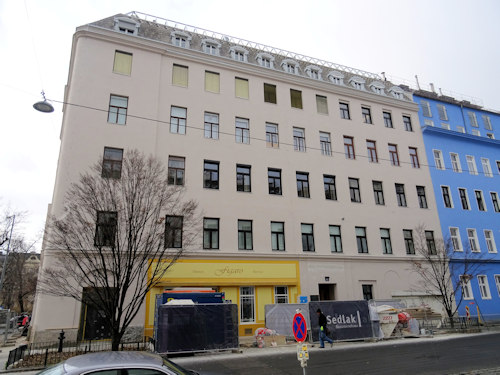
(Sandwiched between the Augarten Park and the Donaukanal river)
A rather inoffensive house located at Obere Donaustraße 12 in the 2nd district provided a home for a young Hundertwasser.
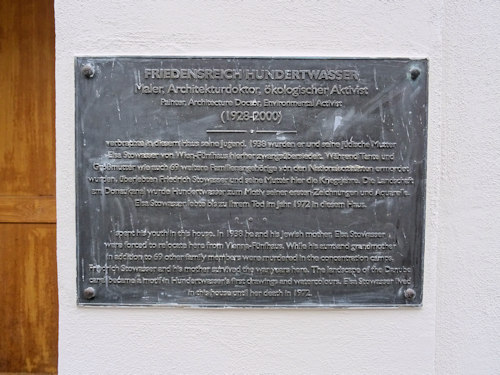
(A rare bilingual commemorative plaque)
A plaque outside the building (in German and English) explains how the Nazis forced Hundertwasser and his Jewish mother to move here in 1938. They both survived the war, though the authorities murdered dozens of their relatives in concentration camps.
(See this overview for more sites, museums, and memorials related to Jewish Vienna.)
The Ankerhaus

(Located right in the pedestrianised centre)
Hundertwasser apparently had a studio at the top of the Ankerhaus, a multi-functional building on Vienna’s famous Graben boulevard. Another great son of the city, Otto Wagner, designed the house itself, which dates back to the mid-1890s.
Hundertwasser square
A small square in Vienna’s 15th district bears the name Friedensreich-Hundertwasser-Platz, though it lies somewhat away from usual tourist routes.
I’ll add more locations if and when I come across them…